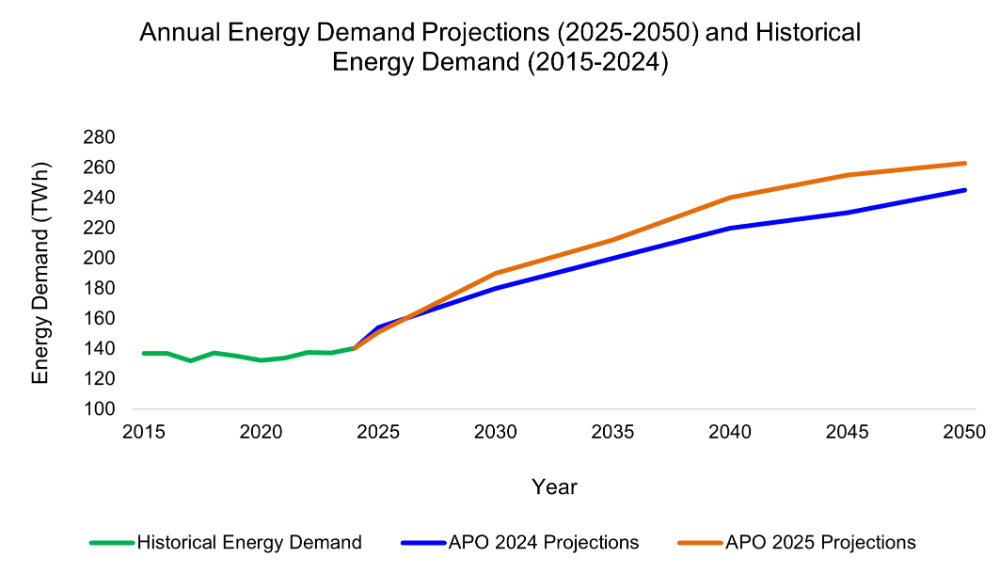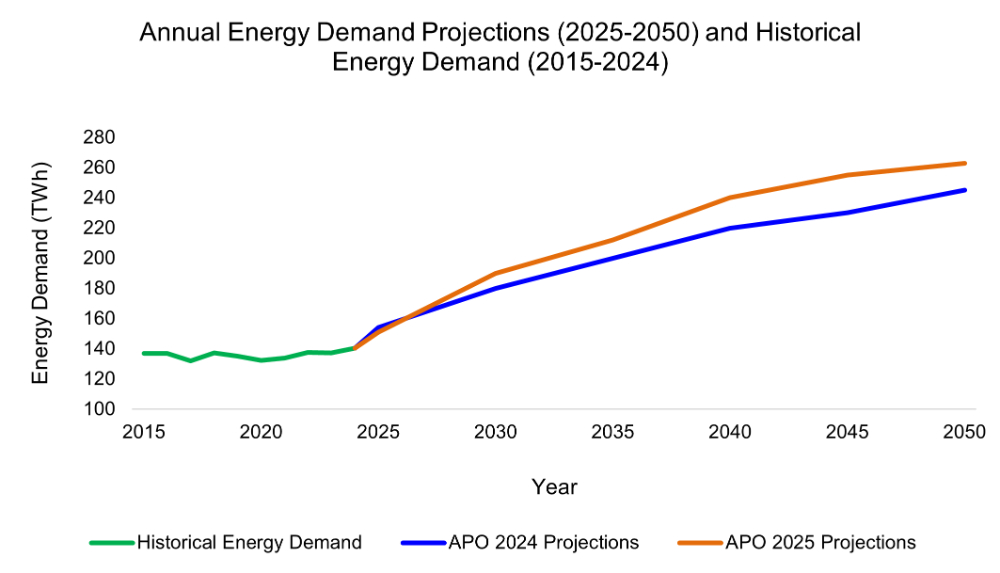- within Compliance topic(s)
- with Senior Company Executives, HR and Finance and Tax Executives
- in Canada
- with readers working within the Healthcare and Law Firm industries
As Ontario's electricity needs continue to grow, the province is undertaking the largest competitive energy procurement in its history. On December 11, 2024, the Ontario Minister of Energy and Electrification (the "Minister"), Stephen Lecce, announced a 50 per cent increase in the energy procurement target under the Long-Term 2 Request for Proposals ("LT2 RFP"). The target has been raised from 5,000 megawatts ("MW") to 7,500 MW, which is estimated to supply energy for approximately 1.6 million additional homes.1
LT2 RFP aims to procure new electricity generation capacity to with a stated focus on integrating non-emitting energy sources, protecting prime agricultural land, and fostering of Indigenous partnerships.2
Ontario's energy demands
On October 16, 2024, the Independent Electricity System Operator's (the "IESO") published its annual forecast which anticipates that electricity demand in Ontario will grow 75 per cent by 2050.3 This forecast represented a significant increase from the 60 per cent by 2050 growth figures projected by the IESO just seven months earlier in March 2024.4
Shortly after the release of the updated forecast, on November 28, 2024, the Energy Minister directed the IESO to undertake the LT2 RFP procurement initiative and secure additional electricity generation capacity to meet these growing energy needs (the "Directive"). The Directive attributed the accelerated pace of electricity demand to population growth and to expanded commercial and industrial sector growth, including expanded electric vehicle supply chain manufacturing and, crucially, the rapid build out of data centres.5

Figure 1: Graph showing the annual energy demand
projections for 2050 based on the IESO's October 16, 2024
Annual Planning Outlook (APO 2025)and March 19, 2024
Annual Planning Outlook (APO 2024).6 Data for
2024 (Reference Year) is based on the 2024 IESO energy demand
forecast of 140.3 TWh.7

Figure 2: Graph showing the annual energy demand
projections based on the IESO's October 16, 2024, Annual
Planning Outlook (APO 2025)and March 19, 2024 Annual
Planning Outlook (APO 2024).8 Historical data for
the years 2015 to 2023 is obtained from the historical demand
reported by IESO.9 Data for 2024 is based on the 2024
IESO energy demand forecast of 140.3 TWh.10
LT2 RFP procurement plan
The goal of LT2 is to help ensure that Ontario has the power capacity to meet growing electricity demand into the 2030s. LT2 is described as transparent, competitive and, crucially, as 'technology-agnostic'.11 LT2 can be thought of as being divided into two work streams:
- The Energy Stream: targeting the acquisition of contract capacity sufficient to enable the production of up to 14 terawatt-hours ("TWh") of annual electricity generation from newly-built facilities.12
- The Capacity Stream: targeting energy 'capacity' of up to 1,600 MW, this stream is designed to address peak demand and ensure grid reliability during high-demand events. 13
LT2 will see multiple submission windows under each stream as separate requests for proposals are issued by the IESO.14 Together, the Energy Stream and the Capacity Stream are intended to strengthen Ontario's energy system, addressing current needs and supporting future power demand growth.
The LT2 RFP procurement documents
The IESO has made available draft procurement documents for the Energy Stream and Capacity Stream, including requests for proposals and contracts, to provide transparency and gather stakeholder feedback. The final draft documents for the first LT2 RFP window are expected to be made available in Q1 of 2025. The most recent draft requests for proposal and contracts for the Energy Stream and Capacity Stream which, according to the IESO, are unlikely to differ substantially from the final versions, were posted by the IESO on December 20, 2024,15 and include:
- Energy Stream Documents:
- Long-Term 2 Energy Supply (Window 1) Request For Proposals ("e-1 RFP").
- Long-Term 2 Energy Supply (Window 1) (LT2(e-1)) Contract ("e-1 Contract").
- Capacity Stream Documents:
- Long-Term 2 Capacity Services (Window 1) Request For Proposals ("c-1 RFP").
- Long-Term 2 Capacity Services (Window 1) (LT2(c-1)) Contract ("c-1 Contract").
Below, we examine the Energy Stream Documents and the Capacity Stream Documents and provide some initial comments. (Capitalized terms not otherwise defined in this article have the meaning ascribed to them in those documents.)
Energy Stream documents
Under the Energy Stream, the milestone date for commercial operation of the supplier's facility is set at May 1, 2030 (the "Milestone Date"), and the commercial operation date ("COD") must be achieved no later than 18 months after the Milestone Date, or by November 1, 2031.16 Under the e-1 Contract, suppliers can earn higher payments by achieving commercial operation prior to April 30, 2030 (the "COD Bonus End Date"). Suppliers who achieve a COD prior to April 30, 2029, would realize the highest early COD payment multiplier (see Table 1).
Further, where commercial operation of the supplier's facility is achieved prior to the COD Bonus End Date, the e-1 Contract entitles the supplier to apply a fixed payment multiplier to the Fixed Price (as defined in the e-1 Contract), which will be determined based on the time period in which the COD was achieved. The deadlines for each of the noted dates are fixed and unaffected by delays or external disruptions -including, notably, force majeure events. Failure to achieve commercial operation before November 1, 2031, results in a supplier event of default.
|
Commercial Operation Date |
Early COD Payment Multiplier |
|
Prior to and until April 30, 2029 |
1.5 |
|
From May 1, 2029 to December 31, 2029 |
1.4 |
|
From January 1, 2030 to April 30, 2030 |
1.2 |
Table 1: The Commercial Operate Date and associated payment multiplier.17
As noted in the e-1 RFP, the e-1 Contract is structured as a financial guarantee to ensure the supplier's monthly revenue requirements are met by way of an imputed revenue model (the "IMR"). The IMR calculates hypothetical earnings based on the supplier's production and market conditions.18
If a supplier's imputed market revenues fall short of their monthly revenue requirement, the IESO pays the difference. Conversely, if the revenues exceed the requirement, the supplier refunds the excess to the IESO. The revenue requirement is calculated using metrics which include:
- Indexed Fixed Price ($/MWh): Adjusted annually for inflation after the first year.
- Annual Average Imputed Production Factor: A measure of facility efficiency.
- Contract Capacity: The supplier's committed capacity.19
Market revenues are calculated based on the imputed production price, production factors, and operational hours in the month. Starting in the second year, 20 per cent of the fixed price is inflation adjusted yearly.
Suppliers are entitled to retain revenue from Environmental Attributes, Capacity Products, and Ancillary Services (each as defined in the e-1 Contract), which are excluded from imputed market revenue calculations.20
Starting after the third contract year, suppliers must meet a minimum performance factor, which is at least 80 per cent of the annual average imputed production factor which would be determined in the e-1 Contract. If the facility's Actual Performance Factor falls below this threshold, a non-performance charge will be applied for the relevant settlement month (see Table 2). This charge is deemed as liquidated damages—a pre-estimated measure of the buyer's losses—and is not considered a penalty.21
|
Actual Performance Factor Calculation |
|||||
|
Formula: |
|
||||
|
Where: |
|||||
|
APFp: |
is the Facility's Actual Performance Factor (expressed as a percentage figure) for the most recent three (3) Contract Years period "p". |
||||
|
TFEp: |
is the total Delivered Electricity measured over the most recent three (3) Contract Years period "p". |
||||
|
CC: |
is the Contract Capacity (in MW). |
||||
|
THp: |
is the total number of hours in the most recent three (3) Contract Years period "p". |
||||
|
EHp: |
is the total number of "Excluded Hours" in each Settlement Month measured over the most recent three (3) Contract Years period "p", being the total of all hours (or partial hours) in such period, without duplication, that are:
|
||||
|
Grid-Based Unavailability Hours: |
is the total number of hours (or partial hours) that are the subject of Grid-Based Unavailability. Grid-Based Unavailability means an Outage, other than a Planned Outage, not claimed as Force Majeure, for which the Supplier has complied with the Outage reporting requirements and demonstrated to the Buyer, acting reasonably, that:
|
||||
Table 2: Actual Performance Factor Calculation as provided in the in e-1 Contract, capitalized terms are defined in the e-1 Contract.22
Capacity Stream documents
The c-1 Contract is designed to address system reliability by compensating suppliers for ensuring their facility's capacity is available during the specified commitment period. Under the c-1 Contract, suppliers are required to offer their contract capacity into the IESO-administered markets during defined qualifying hours, which typically run from 07:00 to 23:00 EST on business days or another continuous 16-hour period prescribed by the IESO. These qualifying hours can apply for up to five days in any calendar week.23
The IESO retains the right to adjust the continuous 16-hour period defining the Qualifying Hours, providing 90 days' prior written notice, and may do so up to twice in any given contract year. This flexibility is intended to ensure that the provincial grid can adapt to changing reliability needs while maintaining the supplier's obligation to support system stability.24
Under the c-1 Contract, the Milestone Date to achieve commercial operation mirrors the requirements under the e-1 Contract discussed above, as do the deadlines associated with the COD Bonus End Date, and the COD payment multiplier metrics. The key distinction being that this only applies to a non-electricity storage facility.25
The c-1 Contract provides suppliers with a fixed monthly capacity payment to compensate for their facility's availability. This payment is calculated using what is termed the Fixed Capacity Payment ("FCP") rate (in $/MW-Business Day), multiplied by the number of business days in the month and the supplier's monthly contract capacity. The FCP is determined based on the supplier's proposal price submitted under the c-1 RFP. Under the c-1 Contract, the maximum contract capacity cannot also exceed 95 per cent of the facility's nameplate capacity.26
Additionally, all revenues generated by the facility from participating in the IESO-administered markets or from other attributes and products (e.g., Ancillary Services or Environmental Attributes, as defined in the c-1 Contract) will remain entirely with the supplier. These revenues are separate from the monthly capacity payment and are retained by the supplier as an added financial benefit.27
The c-1 Contract includes key performance obligations for suppliers which are distinct from those under the e-1 Contract. The primary covenant of the c-1 Contract, the "Must-Offer Obligation," requires suppliers to make electricity from their facility's available Contract Capacity into the IESO's day-ahead market during qualifying hours each settlement month. The Monthly Average Offered Quantity ("MAOQ"), calculated as the total MW offered during qualifying hours divided by the number of qualifying hours in the settlement month, must meet or exceed the Adjusted Monthly Contract Capacity. After the third contract year, a supplier event of default occurs if the average Monthly Average Offered Quantity over any 36-month period falls below 65 per cent of the Adjusted Monthly Contract Capacity. For electricity storage facilities, the calculation of Adjusted Monthly Contract Capacity accounts for qualifying hours when their facility is "State-of-Charge Limited," meaning it has expended at least 98 per cent of its Storage Capacity during the applicable Qualifying Hours of the current day or since the end of the last Qualifying Hour of the previous day.28
Where a facility's MAOQ falls below the Adjusted Monthly Contract Capacity at the end of a settlement month, the Supplier will incur an "Availability Non-Performance Charge." This charge is calculated as the fixed capacity payment multiplied by the percentage shortfall and a monthly non-performance factor. As under the e-1 Contract, the charge is levied in the form of liquidated damages.
The RFP Process itself contemplates a proposal evaluation process where by proposals will be rated by the IESO with a maximum of 15 "rated criteria points" available.29 One key criterion which distinguishes the c-1 Contract from the e-1 Contract is the duration of continuous delivery of Electricity to a Connection Point during the Qualifying Hours. Proposals can earn up to three points depending on the project's ability to deliver electricity during Qualifying Hours. A non-storage facility that can deliver continuous electricity for 12 or more hours earns three points, while an electricity storage facility can earn two points for delivering continuous electricity for the same duration. Proposals that can only deliver power for less than 12 hours during the Qualifying Hours receive zero points. Proposals with higher-rated criteria are obviously more likely to be prioritized in the evaluation process, as they can better ensure a reliable energy supply during critical hours.30
Steps to submitting the Energy Stream and Capacity Stream documents31
|
# |
Proposal Document |
e-1 RFP |
c-1 RFP |
|
Required Payments and Documents for the Energy Stream and Capacity Stream RFP |
|||
|
Proposal Fee: |
$13,000.00 |
$13,000.00 |
|
|
Economic Bid Statement: |
Proponents must submit their proposed Fixed Price (in $/MWh) in its proposal for price evaluation under the LT2(e) RFP. Prescribed Form: LT2(e-1)PF-EB100 |
Proponents must submit the Fixed Capacity Payment (in $ per MW per Business Day) in its Proposal for price evaluation under the LT2(c) RFP. Prescribed Form: LT2(c-1)PF-PP100 |
|
|
Proponent Information, Declarations and Workbook: |
Proponents must submit an electronic copy of the Prescribed Form, along with a Microsoft excel proposal workbook detailing the Long-Term Energy Project, including the technology type, fuel source, Project Site details, Connection Point, Monthly Imputed Production Factors and the mandatory and rated criteria information. Prescribed Form: LT2(e-1)PF-PI100 |
Proponents must submit an electronic copy of the Prescribed Form, along with a Microsoft Excel Proposal workbook detailing the Long-Term Capacity Services Project, including technology type, fuel source, Project Site details, Connection Point, and mandatory and rated criteria information. Prescribed Form: LT2(c-1)PF-PI100 |
|
|
Access Rights Declaration: |
Proponents must submit a scale map of the Project Site showing its outer boundary and Connection Point, along with evidence of access rights such as parcel registers or equivalent documents. Prescribed Form: LT2(e-1)PF-AR100 |
Proponents must submit a scale map of the Project Site showing its outer boundary and Connection Point, along with evidence of access rights, including parcel registers or equivalent documents. Prescribed Form: LT2(c-1)PF-AR100 |
|
|
Confirmation of Unincorporated Territory: |
If the Project is located on Unincorporated Territory, the Proponent must submit a completed Confirmation of Unincorporated Territory (Energy) form, along with a confirmation that includes the seal or certificate from a Land Use Planner certified by the Ontario Professional Planners Institute. Prescribed Form: LT2(e-1)PF-CUT100 |
If the Project is located on Unincorporated Territory, the Proponent must submit a completed Confirmation of Unincorporated Territory (Capacity)form, along with a confirmation that includes the seal or certificate of a Land Use Planner from the Ontario Professional Planners Institute. Prescribed Form: LT2(c-1)PF-CUT100 |
|
|
Evidence of Indigenous Support: |
If the Project Site is located on Indigenous Lands, the Proponent must submit electronic copies of Indigenous Support Confirmation(s), dated no earlier than February 27, 2025. Prescribed Form: LT2(e-1)PF-IS100 |
If the Project Site is located on Indigenous Lands, the Proponent must submit electronic copies of Indigenous Support Confirmation(s), dated no earlier than February 27, 2025. Prescribed Form: LT2(c-1)PF-IS100 |
|
|
Evidence of Municipal Support: |
If the Project Site is located on Municipal Project Lands, the Proponent must submit electronic copies of Municipal Support Confirmation(s), including a Municipal Resolution in Support of Proposal Submission or a Blanket Municipal Support Resolution, with the resolution or letter dated no earlier than February 27, 2025. Prescribed Form: LT2(e-1)PF-MS100 |
If the Project Site is located on lands subject to the authority of Local Municipalities, the Proponent must submit electronic copies of Municipal Support Confirmation(s), including a Municipal Support Resolution or a Blanket Municipal Support Resolution, with the resolution dated no earlier than February 27, 2025. Prescribed Form: LT2(c-1)PF-MS100 |
|
|
Evidence of Indigenous Community Participation: |
To earn Rated Criteria Points, the Proponent must submit the Evidence of Indigenous Community Participationform, including documentation of the Economic Interest held by Indigenous Communities. If the Project Site is not on Indigenous Lands, an attestation is required confirming the site is within the Community's traditional territory or covered by a treaty. Prescribed Form: LT2(e-1)PF-IP100 |
To earn Rated Criteria Points, the Proponent must submit the Evidence of Indigenous Community Participation form, including documentation of Economic Interest held by Indigenous Communities. If the Project Site is not on Indigenous Lands, an attestation is required confirming the site is within the Community's traditional territory or covered by a treaty. Prescribed Form: LT2(c-1)PF-IP100 |
|
|
After Making Payments and Submitting Documents for the Energy Stream and Capacity Stream RFP |
|||
|
Selected Proponents: |
The IESO will notify the selected proponents as well as the other proponents not selected. |
The IESO will notify the selected proponents as well as the other proponents not selected. |
|
|
Entering into the Contract: |
The IESO will provide the selected proponents with the e-1 Contract and related closing documents for completion and execution. |
The IESO will provide the selected proponents with the c-1 Contract and related closing documents for completion and execution. |
|
|
Proposal Security: |
$35,000.00 per MW of Contract Capacity (with MW rounded to two decimal places in the event of partial MW), subject to a minimum total amount of $500,000.00 and a maximum of $15,000,000.00 |
$35,000.00 per MW of Contract Capacity (with MW rounded to two decimal places in the event of partial MW), subject to a minimum total amount of $500,000.00 and a maximum of $15,000,000.00 |
|
Table 3: Steps to submitting Energy Stream and Capacity Step documents.32
LT2 RFP process schedule
The IESO's schedule relating to the Energy Stream and Capacity Stream RFP and Contracts are provided below:
|
Milestone |
Energy Stream Dates |
Capacity Stream Dates |
|
IESO's deadline for releasing the final RFP and Contract |
February 27, 2025 |
February 27, 2025 |
|
Proponent's deadline for submitting questions and comments |
April 24, 2025 |
June 26, 2025 |
|
IESO's deadline for issuing Addenda to RFP and Contract, if any |
May 8, 2025 |
July 10, 2025 |
|
Proponent's deadline for registration |
June 19, 2025 |
August 21, 2025 |
|
Proposal submission deadline |
July 24, 2025 |
September 25, 2025 |
|
Target date for notification to selected proponents |
January 20, 2026 |
March 24, 2026 |
Table 4: LT2RFP Process Schedule. This schedule is under consideration by the IESO, and so the IESO may amend the Schedule from time to time by Addendum, which will be posted on the Website.33
Other procurement initiatives underway
In addition to the LT2 RFP process, the Ontario government has now also directed the IESO to explore two new procurement programs aimed at enhancing the province's energy security and sustainability:
- Long-Lead Time Procurement: Set to launch by the end of 2025, this program targets resources with extended development timelines and operational lifespans, such as long-duration energy storage technologies and hydroelectric generation. These investments will play a critical role in ensuring Ontario's energy system remains resilient and sustainable over the long term.
- Local Generation Program: Scheduled for early 2026, this initiative focuses on smaller-scale, distribution-connected resources such as solar, biogas, wind, and combined heat and power systems. By promoting localized energy production, the program aims to reduce transmission demands and enhance community energy resilience. Smaller-scale, community-connected projects (e.g., solar, wind, biogas) starting in 2026.34
Strengthening partnerships
To complement these procurement efforts, the Ontario government is also seeking to reinforce its energy partnerships to ensure a reliable and diversified supply:
- Hydro-Quebec Trade Agreement: Building on the 2024 Capacity Sharing Agreement, the Ontario government has directed the IESO to establish a new electricity trade agreement with Hydro-Quebec. This 10-year agreement will provide access to additional electricity during nuclear refurbishments, strengthening Ontario's grid reliability and leveraging the complementary characteristics of the two provinces' electricity systems at no additional cost to consumers for the traded capacity.
- Atikokan Generating Station: A new agreement with Ontario Power Generation's Atikokan facility, located in Northern Ontario, will further enhance the province's energy supply by leveraging biomass-powered generation capabilities.35
Conclusion
The LT2 procurement and complementary initiatives represent a significant shift of approach to addressing Ontario's anticipated energy needs. By combining long-term planning with innovative solutions, these measures aim to create a sustainable and reliable energy system that supports economic growth, meets climate goals, and ensures energy security. As these initiatives unfold, they are likely to play a pivotal role in meeting the evolving energy needs of the province while at the same fostering economic opportunity and industrial capacity.The IESO's LT2 RFP aims to secure both energy and capacity resources to address Ontario's growing electricity demand and to support grid decarbonization efforts. Through separate submission windows for the Energy and Capacity streams, suppliers are invited to submit proposals to meet the system's long-term needs and ensure reliable supply into the 2030s and beyond.
Footnotes
1 Government of Ontario, Ontario Expands Largest Competitive Energy Procurement in Province's History (December 11, 2024).
2 Government of Ontario, Ministry of Energy and Electrification, Minister's Directive OC-1553/2024 (November 28, 2024).
3 Independent Electricity System Operator (IESO), 2025 Annual Planning Outlook: Demand Forecast Information Session (October 16, 2024).
4 IESO, 2024 Annual Planning Outlook, Ontario's electricity system needs: 2025-2050 (March 19, 2024).
5 Supra, note 2.
6 Supra, notes 3 and 4.
7 IESO, Real-time Demand Reports(last accessed December 29, 2024).
8 Supra, notes 3 and 4.
9 IESO, Historical Demand(last accessed December 29, 2024).
10 Supra, note 8.
11 Supra, note 1.
12 Supra, note 2.
13 Ibid.
14 Ibid.
15 IESO, Resource Acquisition and Contracts (Long-Term 2 RFP)(last accessed December 29, 2024).
16 IESO, the Long-Term 2 Energy Supply (Window 1) (LT2(e-1)) Contract, at section 2.3.
17 Ibid.
18 IESO, the Long-Term 2 Energy Supply (Window 1) Request For Proposals, at section 2.2.
19 Ibid.
20 Ibid.
21 Supra, note 16, at section 3.1.
22 Supra, note 16 at Exhibit F.
23 IESO,Long-Term 2 Capacity Services (Window 1) Request For Proposals, at section 2.2.
24 Ibid.
25 IESO, the Long-Term 2 Capacity Services (Window 1) (LT2(c-1)) Contract, at section 2.3.
26 Supra, note 23.
27 Ibid.
28 Ibid., see also note 23.
29 IESO,Long-Term 2 Capacity Services (Window 1) Request For Proposals, at section 4.3.
30 Ibid, at section 4.3(e).
31 As noted above, these documents are considered substantially the final draft versions of the linked documents, made available by the IESO on December 20, 2024. This article will be updated with the final links once the final documents are made available by the IESO, and revised accordingly.
32 Supra, notes 18 and 23.
33 Supra, notes 18 and 23, at section 3.1.
34 Supra, note 2.
35 Ibid.
Read the original article on GowlingWLG.com
The content of this article is intended to provide a general guide to the subject matter. Specialist advice should be sought about your specific circumstances.



